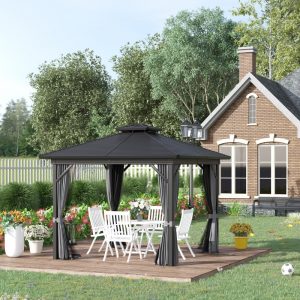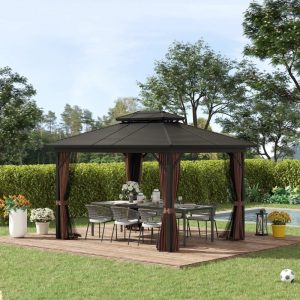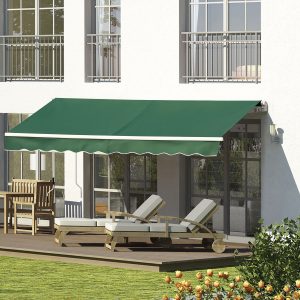Now most home and shop will use an awning canopy at the front of door to prevent sunshine and rain. An awning canopy is a fantastic addition to any garden, patio, or terrace. Not only does it look gorgeous, but it also protects you from the sun, allowing you to enjoy some cool under its shade during a hot day. On the other hand, it’s also prone to accumulating dirty as it’s exposed to various elements.
And while a little bit of dirt won’t hurt your awning, if you let it build up, it might lead to decreasing your outdoor awning’s lifespan and make it more vulnerable to damage. All it takes to prevent this from happening is regular cleaning. Doing this will ensure your awning lasts for a long time without losing its appearance and protective properties.
However, bear in mind that attacking your awning with a brush and water won’t be enough. Cleaning a awning canopy requires the right approach. Otherwise, you may do more harm than good. That being said, if you’re wondering how to tackle the awning canopy cleaning, this guide will provide you with all the information you need. Read on, and give your awning the cleaning it deserves!
A step by step instruction for cleaning an Awning Canopy
There’s more than one approach to cleaning a awning canopy . The instruction below, however, shows by far the most effective way to do it. Please note that these instructions and the recommendation regarding mildew below apply to the canvas only. For solution-dyed acrylic, acrylic, PVC, or polyester, consult with the fabric manufacturer for specific cleaning instructions. So, without further ado, here’s how to clean your awning canopy :
- First, fill a bucket with cool water. Add approximately 3 oz of laundry soap (don’t use detergent!), and mix everything together until it’s foamy.
- Climb up on a ladder or, if possible, take down the awning and, using a broom, remove any dirt, leaves, twigs, or cobwebs from both sides.
- Take your garden hose and spray the awning with water (use a low-pressure setting). Remember to make it substantially wet, not soaking wet.
- Once it’s wet, scrub the awning with a heavy brush and water mixed with laundry soap. We’d recommend using a circular motion when using a brush, as it’s proven to be the most effective.
- Clean the awning thoroughly and evenly. Don’t spend too much time brushing one place to prevent the soap from drying on the canvas.
- If you’ve finished scrubbing the awning, but there are still some stains on it, you can sprinkle those with baking soda. Let it sit for a few minutes and rinse it off.
- Once you’re done with scrubbing, rinse the soap off with your garden hose and let the canvas dry. Again, use a low-pressure setting as a high-pressured water stream may damage the material.
Instruction and Suggestions
When cleaning your awning canopy , there are some good practices you can follow to improve the effectiveness of the entire process. First of all, remember to read the service manual to find out whether your awning can handle a protective coating. Such a solution will make your life much easier, protecting your awning from accumulating dirt, debris, or fungus.
Secondly, if possible, we recommend removing your awning for cleaning. This way, you’ll be able to give it a more thorough cleaning. It will also ensure you don’t fall down the ladder when scrubbing the canvas. If you can’t take it down, ensure the ladder is sturdy and your surroundings protected.
Dealing With Mildew on a Awning Canopy
Water with laundry soap will do just fine when dealing with regular dirt. However, if your awning canopy begins to show signs of mildew, it’s time to go for more radical measures. By that, we mean bleach.
In general, the basics remain the same as when cleaning dirt. The only difference is that you use a small amount of bleach in addition to soap. When it comes to the exact amount, take 230 ml of bleach per gallon of water with around 60 ml of laundry soap.
Important note. Use color-safe and chlorine-free bleach. You should also have a suitable fabric protecting treatment spray. Otherwise, you might damage the fabric.
The best idea here, though, is to keep your awning mildew-free, which is far easier than scrubbing it off the canvas. To ensure mildew doesn’t show up, you should spray the awning with water at least once a month. It’s also important to clean it once in a while using laundry soap (as described in our step-by-step guide).
Another important thing is to store your canvas properly, which will also prevent it from attracting mildew or fungus. Keep it sealed in your storage room during the winter, and make sure it’s completely dry before you store it.
Awning Canopy and Frame Washing
When cleaning your awning canopy , you might feel tempted to power wash them. Don’t. Although power washing might seem like an effective and harmless way to clean awnings, it can actually do a lot of damage. It can rip the fabric, and it will ruin the material, stripping away awnings’ UV protection properties. Always use a low-pressure water stream from your garden hose when dealing with canvas awnings or any other type of fabric used for your retractable awning.
Is Thorough Cleaning That Important?
Yes, it is. Without regular maintenance and cleaning, your awnings will soon lose their look and sun protection properties. However, if you know you can’t sacrifice some time every now and then to clean your canvas awnings thoroughly, we recommend choosing aluminum awnings.
They are less prone to accumulating dirt, and since they aren’t made from fabric, they don’t soak in mildew or mold. Of course, regular cleaning is still a necessity, but it’s a much faster process compared to canvas awnings.
To clean an aluminum awning, spray it with a garden hose and use a soft-bristled brush to get rid of dirt. If it doesn’t help, you should go through a similar process to cleaning canvas awnings. Still, it will be much faster than when dealing with canvas.
Final Tips on Cleaning Awning Canopy
Cleaning an awning canopy is not rocket science, and it only requires three things – water, laundry soap (and bleach if dealing with mildew), and a brush. However, it does require a bit of effort and, most importantly, thought. Otherwise, you risk doing more damage than good.
And as for the frequency of your cleanings, it depends on the scale. When it comes to brushing debris like leaves or twigs, you should do it as often as possible. On the other hand, regarding more thorough cleaning, doing so at least once a month should ensure your awnings remain mildew-free and keep protecting you from the sun.
There’s also one more thing we’d like to mention. You can avoid any more significant problems if you equip your property with top-quality canvas awnings. For this purpose, make sure to check out our selection. At Retractable Awnings, we recommend only the best retractable awnings, canopies, screens, or pergolas.
https://www.lidagarden.com/product-category/awning/






It helped when you said that fungus could be prevented if you installed your awnings properly. After moving to our current area, my wife mentioned to me that she wants to have a canvas canopy for our home to prevent the sun’s heat and glare and asked if I have any idea what is the best option to do. Thanks for helping me understand, I’ll be sure to consult a well-known awnings company in town as they can answer all our inquiries.
Hi john,
Thanks so much for your comment.